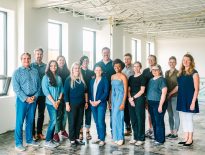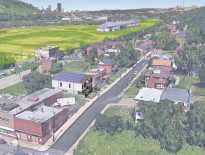Building for Health and Resilience with the Living Building Challenge
Architectural Nexus Turns Living Building Aspirations into Reality
The Living Building Challenge has always been about much more than buildings. The influence that the program has had on one architecture firm is a powerful case in point. Architectural Nexus is a 125-person firm with offices in Salt Lake City and Sacramento. Their understanding of architecture’s opportunity—to be an agent of human health and climate resilience—led them to engage the Living Building Challenge and certification for their own offices as well as for client projects. They haven’t been the same since.
Their Sacramento office project earned bragging rights for the firm. It was the the first Living Building certified in California. That certification was secured in 2017, after which the firm worked with the Living Building Challenge on such projects as the Living Tiny Homes, three residences in Moab, Utah. And they are hard at work on a renovation of the Salt Lake City office (original structure dating to 1955); their goal is Living Building Certified.
In Sacramento, the team found its way to Living Building certification in part as a response to the drought in California. Their Sacramento office was in a leased space and they were looking to create a new office space that embraced company values of inspiration, stewardship, and regeneration. They decided to renovate the 1954 structure. Erica McBride, LFA, Regenerative Operations Manager at the firm, says the team “wanted a building that would be self-sustaining with respect to water.” A focus on the Water Petal seemed natural, but soon they were drawn to a bigger, more holistic goal. “We wanted to demonstrate that a renovated building could be a model for water effectiveness and integrate with its ecosystem,” she says.
It is our mission to demonstrate regenerative design in our practice.
The best way to do that is to be in a Living Building.
Brian Cassil, Director of Communications with Architectural Nexus, says “In Sacramento, we found that the Living Building process ignited our shift toward regenerative design.” The success of the small Sacramento building was a motivator for many projects. “It is our mission to demonstrate regenerative design in our practice. The best way to do that is to be in a Living Building,” Cassil says. “We wanted to extend the success of Sacramento in a larger Salt Lake City office.”
In 2009 the firm renovated the building for the first time and achieved LEED platinum certification. After experiencing the positive impact from the design and operation of the Sacramento office the firm decided to take advantage of working from home during the pandemic and completed renovation on their Salt Lake City office to deepen their commitment and enrich their culture with a regenerative environment for their entire company .The process is underway, and it has been instructive and, at times, a reach—like finding a new muscle in the practice. The commitment to learning in its own offices has inspired the entire firm to think about operations and human habits that make a building thrive.
“We talk about the Living Building Challenge with clients and consultants, and it’s very straight talk about risks, and costs,” Cassil says. “But we have learned so much, and it is immensely, continually rewarding,” McBride says that the learning has influenced all the work. “We see ways to bring aspects of the Living Building Challenge into every project,” she says.
Cassil adds that the benefits are increasingly easy to articulate. “We talk to clients about healthy materials, about energy efficiency and its direct ROI, about biophilic features, and daylight.,” he says. “Is every client going to commit to a water-positive design? No. But every project can benefit from these measures. Energy-positive design is getting easier to sell every year. And the Living Building Challenge is a potent way to implement these strategies and prove the benefits.”
One of the benefits to this firm is having a life-size proof of concept to share with others. “We are constantly doing tours,” McBride says of the Sacramento office. “People have never experienced a building like this.”
Cover image © Architectural Nexus
Your donation supports community impact
Do you want to be part of making lasting change? Around the world, there is a community of people working towards a living future every day. In ways great and small, they are changing minds, overcoming obstacles, and bringing ambitious projects to life. Individually, they cause ripples that show what’s possible. Collectively, they envision the regenerative future that we all want. Will you join us in this transformative work? Your donation to the International Living Future Institute equips us to assist this community with programs, technical support, events, education, and more. Your donation will help us realize what’s possible together.


